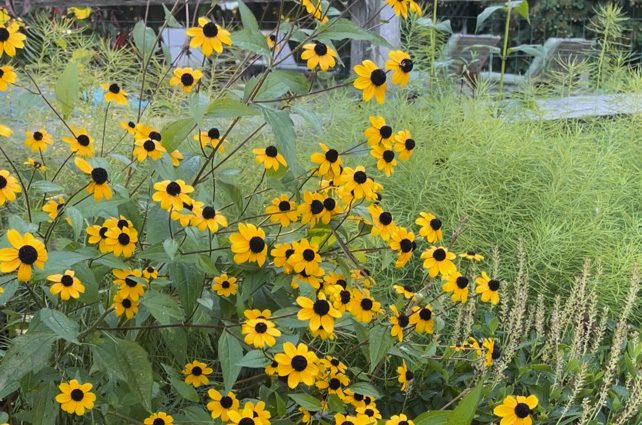designed for the way women work.

Tips To Achieve A Beautiful Garden in Mid Summer by Jeannette Ross
Category: Presenting "The Curious Gardener"
I’ve heard it said that it’s easy to have a fabulous garden in the spring, but having a fabulous garden in the middle of summer is more of a challenge.
Summer brings stress for many of our plants, from hot weather to drought to drenching thunderstorms. Last year we had an unusually long dry spell in the middle of summer here in New England and my hydrangeas took a visible hit. I was afraid of depleting my well if I kept watering them.
But summer also brings many blooming flowers. When planning a summer garden, consider plant selection, plant placement, and maintenance when striving for a ‘fabulous’ garden.
Plant selection Tips:
The water crisis facing California and Arizona should have us all taking a good look at what we are growing in relation to where we live. Native plants are native to a region for a reason. They have adapted to specific conditions. Non-native ornamental plants do not always have that advantage.
Michael Arnold, PhD., of the Texas A&M College of Agriculture, advises gardeners to look to “heat-tolerant plants like tropicals and summer-loving annuals.” He also points to xeric plants – those that cope with low-moisture environments.
- Heat Tolerant Plants: According to horticulturist Ruth Clausen, there are plenty of good plant choices for hot summer gardens, such as coreopsis, day lilies, heuchera, monarda, nepata and rudbeckia. Look for Ruth’s longer list at the bottom of this article.
- Drought Tolerant Plants: Ruth Clausen also has a list of drought tolerant plants which includes allium, yarrows, coneflowers and lantana. Scroll down to see her list.
- Annuals are a good choice for continuous blooming throughout the season. Most annuals will keep blooming if they are deadheaded consistently. The list includes cosmos, calendula, annual salvia, verbena and zinnias. Add to that tropical and xeric varieties, which of course, love hot weather.
Plant Placement Tips:
If you have plants that don’t do as well in the intense sun try placing them in an area that gets afternoon shade, or under the leaves of a larger or taller plant.
Companion planting takes into account that some plants benefit from being placed near others. We can learn alot from the Native American tradition called Three Sisters, which includes corn, beans and squash. The corn, a heavy feeder, grows tall, providing a pole for the beans, which add nitrogen to the soil. Squash is planted at the base of the corn where its broad leaves and prickly stems keep weeds in check and discourage animals. Read more here in our story about Rebecca Webster of The Oneida Nation: Native American tribes “Three sisters.”
Maintenance Tips:
- Deadheading will prevent some perennials from looking tired by midsummer. Cutting a stem above a leaf bud where you see new growth will stimulate those lower buds to develop and produce more flowers. Perennials that respond well include pincushions such as “Butterfly Blue” (scabiosa), purple toadflax (Linaria purpurea), and coreopsis. Cutting the stems of strong, spiky plants will encourage blooms on lateral branches. These include meadow and summer phlox, obedient plant, salvias, campanulas, monkshood, and yarrow. Lady’s mantle, catmint and some hardy geraniums, like G. endressei “Wargrave Pink,” can be cut to the ground after flowering, which will result in new foliage and perhaps some flowers. Try cutting shasta daisies after their second flush. You will be rewarded with more blooms.
After a severe cutting, give the plants a deep watering.
- Water plants as early in the morning as possible to reduce evaporation. The average vegetable garden needs one inch of water per week. This translates into 62 gallons for a 10×10 area, 20 gallons for a 4×8 raised bed.
- Be an assertive weeder. After all, weeds compete for water and nutrients with your flowers and vegetables.
Ruth Clausen’s List of Heat Loving Plants:
- Coreopsis spp.and cvs. Tickseeds
- Gaura lindheimeri Wand flower
- Helenium spp.and cvs Sneezeweed
- Hemerocallis spp. and cvs Day lilies
- Heuchera spp. and cvs Coral bells, alumroot
- Liriope spp. and cvs Lilyturf
- Monarda spp. and cvs Beebalm
- Nepeta spp.and cvs Catmints
- Rudbeckia spp.and cvs Black-eyed Susans
- Veronica spp and cvs Speedwells
- Yucca spp. Yucca
Ruth Clausen’s List of Drought Tolerant Plants:
- Achillea spp. and cvs Yarrows
- Agastache spp.and cvs Anise hyssop
- Allium spp. Ornamental onions
- Amsonia hubrichtii Arkansas bluestar
- Asclepias tuberosa Butterfly weed
- Baptisia cvs False indigo
- Echinacea spp. and cvs Purple coneflower
- Echinops cvs Globe thistle
- Eryngium spp. Sea hollies
- Gaillardia cvs Blanket flower
- Iberis sempervirens Evergreen candytuft
- Knautia macedonica Knautia
- Lantana camara Lantana
- Lavandula cvs Lavender
- Liatris spp. and cvs Gayfeathers, blazing stars
- Penstemon pinifolius Pineleaf penstemon
- Perovskia atriplicifolia Russian sage
- Salvia spp. and cvs Sages
- Sedum spp. and cvs Stonecrops
- Stokesia cvs Stokes’ aster
- Vernonia spp. Ironweed



Thanks for the tips and the list! It would also be helpful to know which plants on your list are deer-resistant. For example, in my garden catmint is happily unmolested, but day lilies (flowers and leaves) are consistently munched by deer.